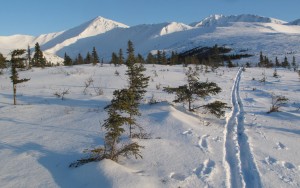The year without a summer
April 12, 2013

Ned Rozell
4/12/2013
An April snowstorm whirling outside my window today seems to be announcing the postponement of spring. As I sit here watching the show, it makes me think back to the shortest summer ever.
In 1992, it snowed more than 9 inches on May 12th. A string of 70-degree days that followed ate that up in a hurry, but the snow returned in early fall. By September 13th, more than one foot of snow cushioned the ground, and leafed birch trees arced under the weight of ice crystals. Twenty-one years later, some trees still bow to that memory.
I wondered if 1992 was the best example of a year without a summer. The perfect man to ask is Rick Thoman of the National Weather Service. Besides having an encyclopedic memory of Alaska weather events, after 20 years as lead forecaster in the Fairbanks office, Thoman just started a new job as the Weather Service’s Climate Science and Services Manager.
As usual, he sharpened my memory.
“Ninety-two was actually a warm summer, bracketed by heavy snows,” he said.
A better example of a year without a summer was 1981, he said. Every month of the summer was cooler than normal in Anchorage, and 1981 was the only year in the last three decades during which Fairbanks had no June, July or August with an average temperature of 60 degrees Fahrenheit or warmer.
An even colder summer was in 1922. In an Alaska climatological record book is a report from the captain of the U.S. Revenue Cutter Bear, which, sailing southward along the coast, encountered sea ice as far south as Point Lay on August 24th. Also in 1922, the official weather station at the experimental station on the University of Alaska Fairbanks campus registered a below-freezing temperature every single month of the year.
“It’s the only year that ever happened,” Thoman said.
Alaska can be a cold place in summer. The official low for Anaktuvuk Pass on June 25, 1967, was minus 1 degree Fahrenheit. Barrow dropped to 4 degrees Fahrenheit on June 6, 1969. Alaska weather observers have never recorded an official temperature below zero in July or August, but summertime lows below freezing are common in Alaska’s upper Tanana Valley and Fortymile River country.
“Which is why it’s hard to grow a garden in Tok,” Thoman said.
Snow has fallen in Alaska at lower elevations in every month of summer. On a midsummer day 10 years ago (July 17, 2003), more than six inches fell on Cantwell.
Now, on to warmer thoughts. Alaska has cooled a bit according to a recent study by climatologists, but they note that most of that colder weather happened in winter, with summer temperatures holding steady for the first decade of the century. Alaska’s all-time high temperature of 100 degrees Fahrenheit (the same as Hawaii’s) happened on June 27, 1915 in Fort Yukon.
And one of the hottest Alaska summers on record was 2004, which was the only year Anchorage has recorded a monthly average temperature warmer than 60 degrees Fahrenheit for June, July and August. That summer was also the warmest in the last 32 years in Juneau. But it was also a year when patches of Alaska equal in area to Vermont burned, smoking every living creature in the Interior like a salmon. Living in that brown haze altered some peoples’ desire for the warmest summer possible.
“The only criteria I use is smoky bad, not smoky good,” Thoman said.


